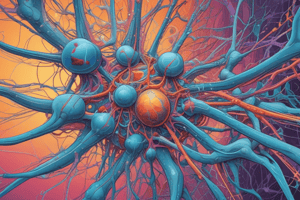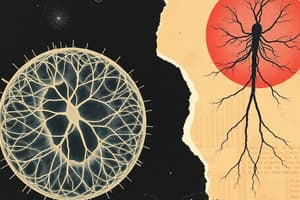Podcast
Questions and Answers
What type of movement is exhibited by macrophages and leucocytes in our body?
What type of movement is exhibited by macrophages and leucocytes in our body?
- Ciliary movement
- Amoeboid movement (correct)
- Flagellar movement
- Muscular movement
What is involved in amoeboid movement?
What is involved in amoeboid movement?
- Contractile muscles
- Pseudopodia and cytoskeletal elements like microfilaments (correct)
- Cilia and flagella
- Neural coordination
Where does ciliary movement occur in our body?
Where does ciliary movement occur in our body?
- Nervous system
- Most of our internal tubular organs lined by ciliated epithelium (correct)
- Digestive system
- Muscles and tendons
What is the function of coordinated movements of cilia in the trachea?
What is the function of coordinated movements of cilia in the trachea?
What is required for locomotion and other movements by human beings and majority of multicellular organisms?
What is required for locomotion and other movements by human beings and majority of multicellular organisms?
Flashcards are hidden until you start studying
Study Notes
Amoeboid Movement
- Macrophages and leucocytes move using amoeboid movement, which involves the change in shape of the cell.
- Amoeboid movement is characterized by the formation of temporary cytoplasmic projections called pseudopodia, which allows the cell to move along a surface.
- Pseudopodia are formed due to the flow of cytoplasm within the cell, driven by the interaction of cytoskeletal components like actin and myosin.
Ciliary Movement
- Ciliary movement occurs in the trachea, bronchi, and other parts of the respiratory system, as well as in the fallopian tubes, and the ventricles of the brain.
- The coordinated movement of cilia in the trachea helps to move mucus and trapped particles upwards, away from the lungs, preventing infection.
- The beating of cilia creates a current, which sweeps the mucus and trapped particles towards the throat where it can be swallowed or coughed out.
Required for Movement
- Locomotion and other movements by human beings and most multicellular organisms require a well-developed muscular system.
- The muscular system works in conjunction with the skeletal system to allow for movement.
- The nervous system controls the muscles, enabling coordinated and purposeful movement
Studying That Suits You
Use AI to generate personalized quizzes and flashcards to suit your learning preferences.




